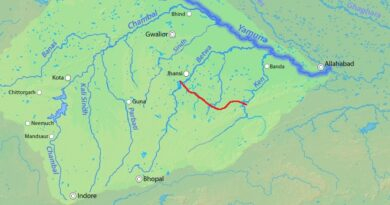Corbett Tiger Reserve
Context:
Recently, the Delhi High Court has asked the National Tiger Conservation Authority (NTCA) to consider as representation a petition to stop the alleged illegal construction of bridges and walls within tiger breeding habitat of the Corbett Tiger Reserve.
About:
- The Project Tiger was first launched in 1973 from the Dhikala zone of Corbett National Park (During its inception, the name of the park was Hailey National Park).
- Together with Sonanadi wildlife sanctuary, Corbett National Park forms Corbett Tiger Reserve spreading over three districts of Uttarakhand i.e. Pauri, Nainital and Almora.
- Corbett tiger reserve is located in Ramnagar in Nainital district.
- Ramganga, Sonanadi, Mandal, Palain and Kosi are the major rivers flowing through the Jim Corbett National Park.
- The reserve, situated factually along a valley between the minor Himalaya in the north and the Siwaliks in the south, has a sub-Himalayan belt shape.
Corbett Tiger Reserve (Jim Corbett National Park)
- On 8th August 1936, India’s first national park was established as Hailey National Park, named after the then Governor of the United Provinces, British India, Sir Malcolm Hailey.
- The reserve area initially consisted of about 324 sq. km.
- The British government had thought of establishing a game reserve as early as 1907 but it was only in 1936 that it came into fruition assisted by hunter-turned-conservationist Jim Corbett.
- It is also Asia’s first national park.
- Soon after the park was established, hunting, killing and capturing of mammals, reptiles and birds were prohibited.
- It was renamed as Ramganga National Park in 1954-55 and again renamed as Corbett National Park in 1955-56.
- Some areas of the park were earlier part of the princely state of Tehri Garhwal. It then passed onto the British and now forms a part of the state of Uttarakhand.
- The park is now governed by the Uttarakhand state government.
- Flora:
- According to the botanical survey of India, Corbett has 600 species of plants – trees, shrubs, ferns, grass, climbers, herbs and bamboos. Sal, Khair and Sissoo are the most visible trees found in Corbett.
- Fauna:
- Apart from tigers, Corbett also has leopards. Other mammals such as jungle cats, barking deer, spotted deer, sambar deer, sloth etc. are also found there.
Facts about Jim Corbett National Park
- When the Government of India launched Project Tiger in 1973, the park became a part of this project.
- The present area of the reserve is 1,318.54 square kilometres (509.09 sq mi) including 520 square kilometres (200 sq mi) of core area and 797.72 square kilometres (308.00 sq mi) of buffer area. The core area forms the Jim Corbett National Park while the buffer contains reserve forests (496.54 square kilometres (191.72 sq mi)) as well as the Sonanadi Wildlife Sanctuary (301.18 square kilometres (116.29 sq mi))
- The reserve is located between the Siwalik Himalayas and the Terai.
- The park is famous for Royal Bengal tigers and Asiatic elephants.
- It contains over 586 species of resident and migratory species of birds making it one of the richest bird regions in India. Birdlife International has declared the area as ‘Important Bird Area’.
- The park has 6 ecotourism zones namely, Dhikala, Bijrani, Jhirna, Sonanadi, Durgadevi and Dhela.
- The national park is a protected area covered by the World Wide Fund (WWF) for Nature under their Terai Arc Landscape Program.
- This program is intended for the protection of three of the five flagship species namely, the Bengal tiger, the Asiatic elephant and the Great one-horned rhino.
- The park’s landscape is diverse including ridges, streams, plateaus, ravines, grasslands, deciduous forests and pine forests.
- The park is home to 488 species of plants.
- The park also has many migratory birds.
- It contains 25 species of reptiles including the Indian python. The park also has 7 species of amphibians including crocodiles and gharials.
National Tiger Conservation Authority
- It is a statutory body under the Ministry of Environment, Forests and Climate Change.
- It was established in 2005 following the recommendations of the Tiger Task Force.
- It was constituted under enabling provisions of the Wildlife (Protection) Act, 1972, as amended in 2006, for strengthening tiger conservation, as per powers and functions assigned to it.
Three-tier protection to tigers at reserves:
- 1st layer of protection: It is provided in the inner range by beat level forest guards through regular patrols.
- 2nd layer of protection: It is provided by STPF.
- 3rd layer of protection: It comes from intelligence-gathering mechanisms in which forest, police and central intelligence agency personnel work together to prevent crimes like poaching of tigers. (Uttarakhand’s Nandhaur Wildlife Sanctuary is set to get a ‘Tiger Cell’ after the Corbett Tiger Reserve)
Other Major Protected Areas of Uttarakhand:
- Nanda Devi National Park.
- Valley of Flowers National Park.
- Valley of Flowers National Park and Nanda Devi National Park together are a UNESCO World Heritage Site.
- Rajaji National Park.
- Gangotri National Park.
- Govind National Park
Source: The Hindu
Also Read
Discover more from Simplified UPSC
Subscribe to get the latest posts sent to your email.



